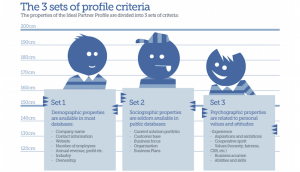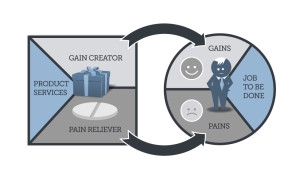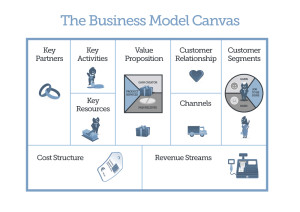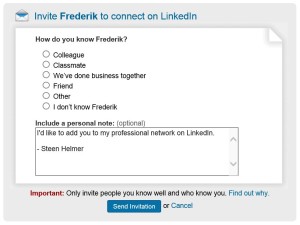How To Succeed As A Software Company With LinkedIn Marketing
 Many people from software companies join LinkedIn with big business development dreams, and rightfully so. It’s been proven by multiple research studies to be the best social platform for business development and lead generation for B2B businesses. This means you’re in the right playing field, but like many other LinkedIn members, you may be playing the wrong game.
Many people from software companies join LinkedIn with big business development dreams, and rightfully so. It’s been proven by multiple research studies to be the best social platform for business development and lead generation for B2B businesses. This means you’re in the right playing field, but like many other LinkedIn members, you may be playing the wrong game.
I have already described how I see the approach from a CEO perspective in my article 6 LinkedIn Recommendations for Software CEOs and how you could implement and execute a strategic LinkedIn plan in your company in this article How to Map Out Your Journey to Become a Social Organization.
This article is all about learning from other people’s mistakes.
9 Big Mistakes People Make on LinkedIn
Mistake #1 = Not knowing the profile of your Ideal Customer
When somebody asks you who your customers are, most people are very broad in the description of their target audience. The broader you define your target audience the more difficult it will be for you to get to know their challenges and pains.
The Fix
You should try to find your IDEAL CUSTOMER PROFILE and not just a potential customer. Using a structured approach  to define and describe how your ideal customer looks like increases your chances of success when searching for the right companies and persons using LinkedIn Advanced Search.
to define and describe how your ideal customer looks like increases your chances of success when searching for the right companies and persons using LinkedIn Advanced Search.
Mistake #2 = Not knowing your customers primary Jobs, Pains & Gains
If you do not know what daily jobs your customers need to get done, why they can’t sleep at night, how they can solve their challenges and what they can achieve by getting these jobs done, then you won’t know how to help them.
The Fix
 You have to get into your customers shoes. There is an “open source” framework that can help you do that – Value Proposition Design. With a selected team in your company using a workshop format, you will be able to identify and describe the actual situation of your ideal customer. Now you know what to write about in your blog posts and updates.
You have to get into your customers shoes. There is an “open source” framework that can help you do that – Value Proposition Design. With a selected team in your company using a workshop format, you will be able to identify and describe the actual situation of your ideal customer. Now you know what to write about in your blog posts and updates.
Mistake #3 = Not knowing your Customer Value Proposition
If you don’t know your customer’s challenges and pains you don’t know which products and services to offer to them.
The Fix
 Again using a structured approach using the framework Value Proposition Design you will be able to identify how exactly your products and services can help your customers to solve their problems and create the most value. Start with defining and describing your BUSINESS MODEL using the Business Model Canvas.
Again using a structured approach using the framework Value Proposition Design you will be able to identify how exactly your products and services can help your customers to solve their problems and create the most value. Start with defining and describing your BUSINESS MODEL using the Business Model Canvas.
Mistake #4 = Not having a clear Key Performance Indicators (KPI)
Let’s assume that you are normally good at defining goals for your overall strategies and plans – why not do that for your LinkedIn approach as well? If you or your employees don’t know what you would like to achieve by using LinkedIn more strategically and proactively, then you probably won’t succeed.
The Fix
You have to define measureable KPI’s for both your LinkedIn Company Page and for the Personal Profiles. This could be  fx optimized and aligned profiles (focus on: Photo, Tagline, Summary and use of rich media), amount of Followers on company page, connections & followers on personal profiles, frequency for Updates, Blog Posts, personal profile rank, does the right people view your personal profiles etc.
fx optimized and aligned profiles (focus on: Photo, Tagline, Summary and use of rich media), amount of Followers on company page, connections & followers on personal profiles, frequency for Updates, Blog Posts, personal profile rank, does the right people view your personal profiles etc.
Mistake #5 = Not knowing who can help you reach your Goals
Now when you know who your ideal customers are, you don’t necessarily have to only look for their profiles on LinkedIn – there are other ways too.
Think of who might already have good connections with your ideal customers, maybe because they are already doing business with them or they meet in industry communities.
The Fix
 Using LinkedIn Advanced People Search – you should search for these people too. They can be your introduction to your next customer.
Using LinkedIn Advanced People Search – you should search for these people too. They can be your introduction to your next customer.
Mistake #6 = default connect request
I see people proactively sending connection requests, but they don’t include a personalized message telling the person why they want to connect. You’ve probably received a connection request like this one, below.
People just use that stock LinkedIn message that auto-populates. Doing this tells people you don’t care that much, you’re just firing off connection requests to people randomly.
I get probably 10 connection requests a day. Maybe one out of every twenty has a personal message. I normally just accept the personal ones or people I already know. The others I write back and ask for their reason to connect. If I don’t get any answer I ignore them.
The Fix
I’m talking a simple, short personal message. It doesn’t have to be a work of art. But in my opinion it has to explain the  value they seek from me, the value they can offer to me or another reason to connect.
value they seek from me, the value they can offer to me or another reason to connect.
Sending the default message is probably the biggest rookie mistake. In my experience, sending a personalized connection request results in an acceptance rate of 50% – 70%. These are people who don’t even know who you are, cold prospects. LinkedIn users have the mindset of wanting to connect with other business people; you just have to give them a decent reason to accept your connect request. This one simple tactic is still a huge opportunity, because not many people are doing it.
Mistake #7 = profile headshot gone wrong (or non-existent)
People are going to evaluate your LinkedIn profile when you send them a connection request to determine if they want to connect with you or not. You need to make sure that you make a great first impression so they accept your request. There are a couple of key points here.
Obviously, you want to have a professional-looking headshot. One of the biggest mistakes people make is using a company logo instead of a picture of their face, a 20 year old photo or the same photo from their Facebook profile on the beach. And no, it’s not a real common thing but there’s enough people doing it that it warrants mentioning.
The Fix
Your profile picture doesn’t require an expensive photo shoot. All you need is a headshot (shoulders and above), in which your face is clearly visible. Make sure that you look approachable and friendly. You want people to warm to you, not be scared away with a stern or angry looking picture. You CAN wear professional attire, but don’t have to. Sweats are out though. If you really want to, you can invest (still limited figure) to hire a professional photographer to take a stellar headshot. Your choice.
Mistake #8 = bad, boring or non-descriptive headline
The next thing people look at after your picture is your name and headline. Your headline on LinkedIn is really, really important. Typically, what I see people do wrong with their headlines is using: their title, company name. Example: Partner at MKG Associates, LLC. That tells people nothing about WHAT you can do and for WHOM.
The Fix
I recommend you include a benefit statement in your headline. If you’ve got a clear USP (unique selling proposition) or UVP (unique value proposition), include that in your headline. Talk about the kind of people you serve, the kind of businesses that you help. That will make people want to read deeper into your profile. It’s not just to get them to accept a connection request, but also to get them to read your summary section and your posts just below your picture.
So think: “What’s the next step I want my prospect to take after looking at my profile?”
Do you want them to connect with you? Tell them at the bottom of your summary section to send you a connection request. Do you want them to sign up for a strategy session? Include a link to some sort of a landing page. Same with any opt-in offer, webinar, white paper or lead magnet. When somebody first looks at your profile, you want to give them different ways to engage with you.
Mistake #9 = out of the blue “buy my stuff” message
When you first connect with somebody, don’t send a private LinkedIn message asking them to buy your product or service. When you first shake someone’s hand at a business event, do you immediately reach for their wallet? Of course not.
You may have experienced the alternative version of this mistake. This is when you’ve been connected with somebody for a while, but you haven’t ever heard from them. All of a sudden, they send you a private LinkedIn message. “Hey, I saw this really cool tool. It’s called Strikingly…” You probably don’t even read that message.
When I see that kind of stuff coming through, I’m certain it’s from a spam farm in Asia that tricked me into connecting. I feel as though they’ve put me on some list and exploited my email. You don’t want to trigger this feeling in your prospects because it damages your credibility.
The Fix
Connecting with people and then letting them sit for a year is a terrible idea. You must have a way to stay in front of them, regularly. This leads into the nurture campaign approach, working prospects through multi-message campaigns over time, culminating with a call to action.
The type and frequency of your messages depend on your industry. As a general guideline, I’d suggest to message your prospects once every two to four weeks. You should not send them messages once a week, because that feels like a little too much.
You want each message to feel like an informal message that you would send to a friend. People don’t want to feel like they’re just in your marketing machine. The goal is to build their trust, to get them to agree to a meeting or phone call within a short time-frame.
After sending someone a message every three weeks or so, there is a point where you have to back off a little bit. From a long-term strategy a messaging campaign might last a couple of months, with a Call To Action to book a meeting or phone call.
What happens if you don’t get that meeting? Are you just going to forget about them? No, you want to move them into a more long-term nurture campaign and usually with that, we recommend sending them something every month or every two months.
With this, you want them to feel like you just thought of them because you came across this article you suspected they would be into. You want them to feel it’s natural and organic, not part of a contrived marketing campaign.
Are you guilty of these LinkedIn mistakes?
You might have seen some of these mistakes before. You might have even made some of these yourself. If you’re guilty of any of these mistakes, now is the perfect time to correct them. If you’ve still got even one of these problems in your LinkedIn campaign, you’re definitely losing out on potential leads. Implement these simple fixes to get the most return on your LinkedIn investment.
Once you’ve agreed to start using these simple tactics, it’s time to take your lead generation strategies to the next level. You’ll find Open Workshops at www.tbkacademy.com, an individual LinkedIn Business Review or specific individual 1-day workshops.
All of the above training courses can be held in English or 10 other local languages.








